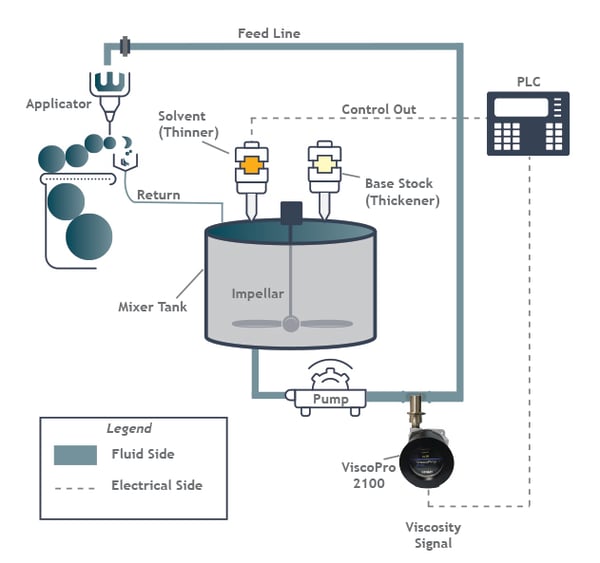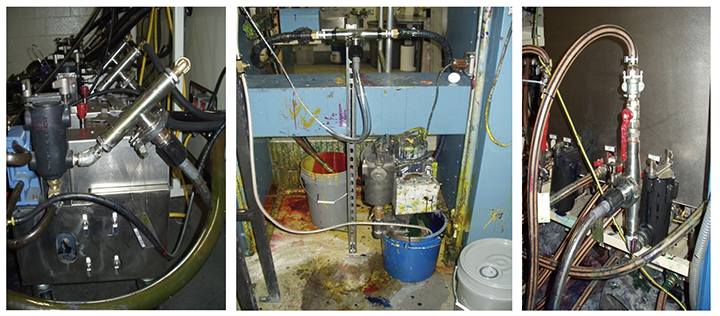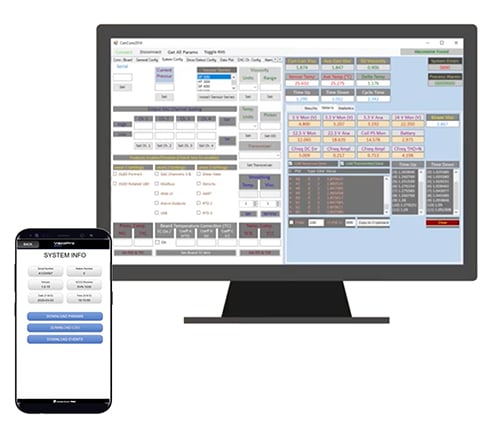Almost two months ago, while those of us in the United States were enjoying our Thanksgiving holiday, our associates in Italy were holding a webinar on viscosity measurement in pressroom converters. This event inspired a series of material discussing the coating application, including last week’s blog highlighting factors that influence viscosity measurement in the pressroom converter application.
This week, we’ll talk about our five biggest lessons that we’ve learned about the pressroom converter application.
Lesson 1: Simple Closed-Loop Control Works Really Well
Sometimes, the simplest route really is the best route. Look at the illustration below.

This illustration represents a typical closed-loop control system. Starting at the mixer tank, you can see degraded material is returned from the process, while new base material enters from the base stock tank and solvent is added from the solvent tank. The function of the mix tank is to blend the materials so the coating or ink that is going to the applicator is perfect. The ViscoPro 2100 monitors and controls material as it is on its way to the applicator, which is the point when the viscosity must meet specification. The in-line viscometer sends its signal to a PLC, which controls the solvent.
Lesson 2: The Best Place to Mount the Viscometer is In the Line
Mounting the viscometer in-line minimizes maintenance and reduces the need for frequent re-calibrations and excess spare parts. In-line mounting also allows the sensor’s environment to be controlled so that the requirement for press operators to maintain the viscosity sensor is minimized, which frees up the press operator time for other responsibilities and reduces the need to carry the expense of spare sensors and parts. Cambridge Viscosity’s viscometers offer a lot of flexibility when it comes to in-line mounting, as shown in the photos below. It gets viscosity sensing away from high activity and high clutter areas around the mix tank.
 In-Line Viscosity Mounting Flexibility
In-Line Viscosity Mounting Flexibility
Lesson 3: Keep Maintenance Requirements Low
The time it takes to clean and maintain a viscometer can really add up – especially when the technician has plenty of other responsibilities. It’s important to choose a low maintenance viscometer. Cambridge Viscosity’s viscometers use a unique oscillating piston technology that delivers a highly accurate, highly repeatable measurement, while also continuously cleaning the chamber. This means maintenance requirements are low, and the operators and focus on other parts of their job.
Lesson 4: An inconsistent ambient temperature can impact a fluid’s viscosity during the process.
Luckily, with a Cambridge Viscosity viscometer, adjusting for the effects of temperature on viscosity is easily accomplished. Cambridge viscometers incorporate a temperature detector in the heart of the sensor so both temperature and viscosity are recorded for each and every measurement. Cambridge’s electronics integrates these to calculate temperature-compensated viscosity so that it can tell whether the concentration measured is on target or not, and then take appropriate action.

Lesson 5: A Simple Operator Interface Makes All the Difference
We’ve found that it’s important to keep the operator interface simple and intuitive. While our sensors provide vast amounts of sophisticated information that is necessary for the complexities of a converting process, our interface is simple and can even be managed using a mobile phone.
If you’re interested in more information on Cambridge Viscosity’s pressroom converter application, download our white paper:
If you have questions, feel free to reach out to our application engineers.






